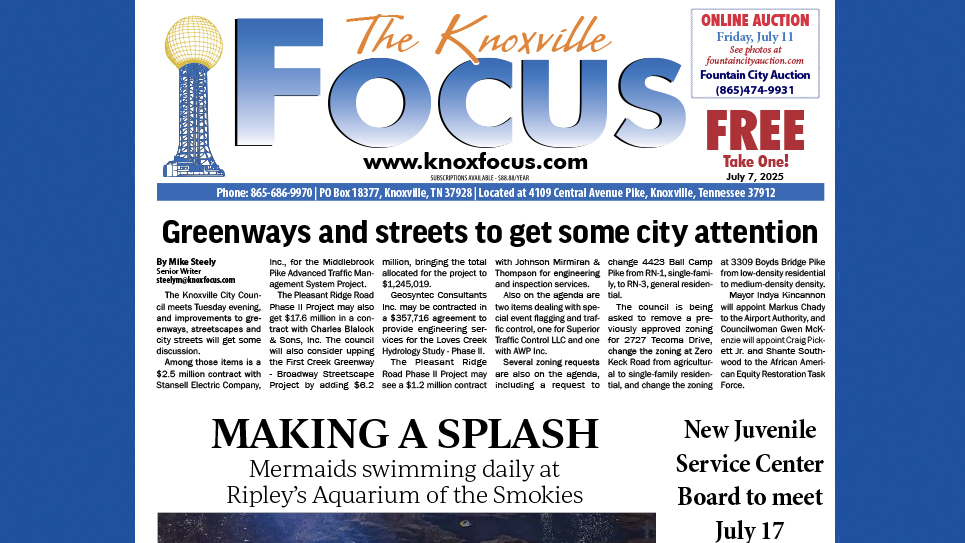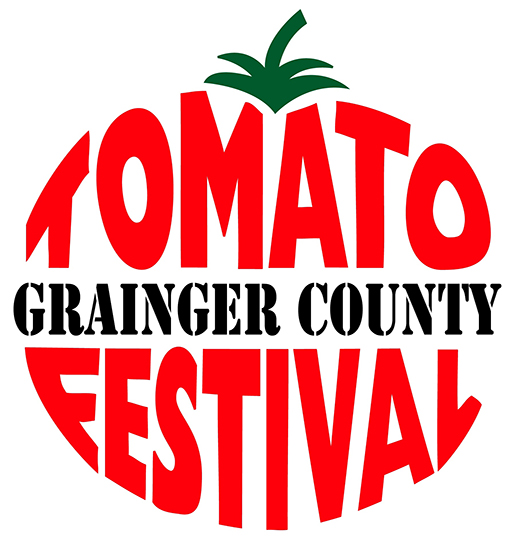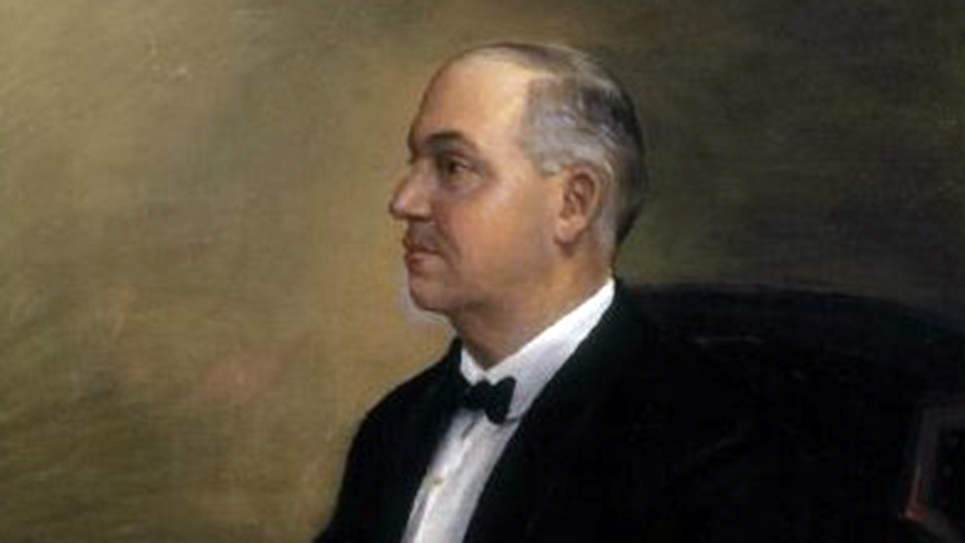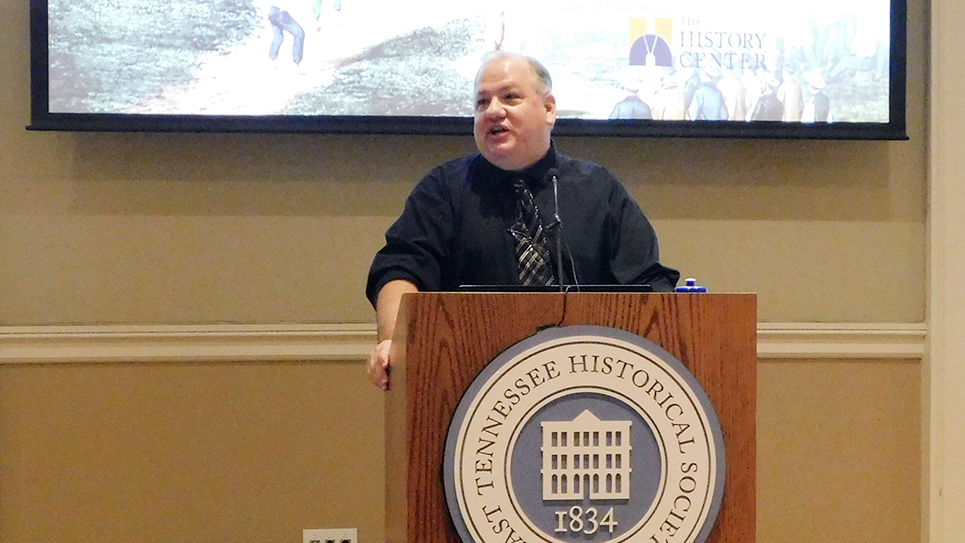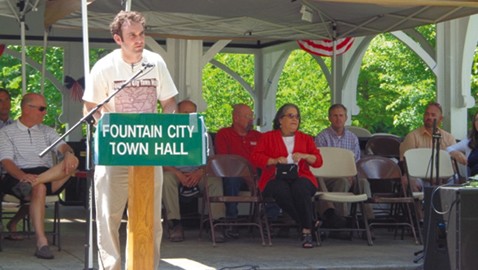
Photo by mike steely
Daniel Dunn, President of the Fountain City Town Hall, spoke at the Memorial Day festivities last week at the Fountain City Park.
By Mike Steely
steelym@knoxfocus.com
Bet you didn’t know that Fountain City started as a military supply depot for North Carolina and Tennessee Territorial militia. Bet you didn’t know that Fountain City was once an incorporated city.
There are lots of things you probably don’t know about our neighborhoods in Knoxville and Knox County. We’ve been surprised at the response to this ongoing feature. Here’s our look at Fountain City and its special place in our local history and the unique things that make it special today.
If you’ve noticed Adair Drive or Adair Park, you may be wondering why the names. Back during settlement days, when the Knoxville area was the last stop before travelers and settlers moved into Cherokee territory, which started at the Cumberland Mountains to the west, the Knoxville area was the last stop. It was a dangerous trip, and the Chickamauga Cherokee were still at war with settlers and travelers.
Captain John Adair built Adair Station, or Fort, in the late 1780s, as a supply depot for the militia that escorted travelers and defended the region. The fort was probably atop the hill where the cemetery along Adair Drive is now located. In fact Adair and his wife are buried there, beneath a large tree, each with a simple marker. The area became, at first, known as Grassy Valley.
The clear, fresh water that bubbled out of the hillside just north of Adair Station was a natural fountain and, with the establishment of Adair Station and the end of the Cherokee hostilities, a settlement developed around the spring. At first it was called Fountain Head but, because another Tennessee town already had that name, Fountain City was chosen. The waters flow from the spring head to the pond and then continue as First Creek.
By the 1920s, Rev. E. F. Sevier founded the Fountain Head Methodist Church, which predates the United Methodist Church. The spring area became a popular church campsite and many meetings were held there.
A three-story hotel, the Fountain Head Hotel, was built on the hill overlooking what is now Fountain City Park, and a small train hauled visitors from Knoxville to the retreat. Later the train was replaced by a trolley.
Businesses and homes developed along the highway and around the lake that was created from the spring waters. By 1906, Central High School was established near the spring, and Hassie K. Gresham became the first female high school principal in the state. When the high school moved to its current location the old high school became Gresham Middle School. Many people don’t know that Gresham was featured in the high school scenes in the movie “October Sky.”
During the era of popularity of the resort a “Dummy Line” railroad ran from downtown to the springs.
Knoxville attempted to annex Fountain City in the 1950s, but the citizens turned the idea down. Finally, in 1962 the larger city took in the smaller city. Some claim that, until the annexation, Fountain City was the largest unincorporated town in the nation, with some 30,000 residents.
The Fountain City Park is about 12 acres with walking paths, playgrounds, and the Fountain City Lions Club Meeting House. The former library at the park is now the Fountain City Art Center.
Some of Fountain City has the look of a small southern town. Along Hotel Road near Broadway are a number of small retail businesses in historic buildings.
A wide variety of business area stretches along Broadway from I-640 to the top of Black Oak Ridge north of Fountain City, where Broadway becomes Maynardville Highway. It is pretty hard to say where Fountain City and the Inskip neighborhood meet but the invisible like is probably along Inskip Road and Bruhin Road from Cedar Lane to Dutch Valley Road. The Heritage Committee of the Fountain City Town Hall association produced a map that shows that the non-existent boundary.
Honor Fountain City Day
Memorial Day was special in Fountain City as the community assembled at Fountain City Park to honor outstanding citizens. The event, held annually since 1972, is sponsored by the Fountain City Town Hall association.
Knoxville Mayor Madeline Rogero spoke at the event about the importance of strong neighborhoods and promised $250,000 in her new budget to restore the Fountain City Lake. She also said there are plans to rework Old Broadway at I-640 and expand the Office of Neighborhoods with a full time assistant. A Memorial Day Ceremony began at 4 p.m. and featured WBIR Anchor John Becker and the East Tennessee Honor Guard.
Daniel Dunn, Chair of the Fountain City Town Hall association, hosted the celebration and honors presentation. He announced that Tyler Pavlis was chosen Friend of Fountain City and the Chairman’s Award to Ken Cloninger. The Residential Beautification Award went to Alfred and Melanie McCoy for their efforts at the home at 318 Lynnwood Drive.
Liz Brown was honored as Fountain City Woman of the year and Jeff Patton was honored as Man of the Year.
Honor Fountain City Day draws hundreds of people, elected officials, political candidates, and visitors. It’s a day full of music, food, speeches, and recognition of military veterans.
The “Neighborhoods of Fountain City” was the theme this year, and tee shirts bearing this slogan were sold.
Entertainment began at 10:30 with the band Nostalgia playing at the covered pavilion. The New Beverly Twirlers performed. Other entertainment included David Correll’s Band, the East Tennessee Concert Band, Tricky Nicky the Magician, the Zoomobile, and activities for children.
Fountain City Town Hall
Founded in 1972 by involved citizens the Fountain City Town Hall is a volunteer community organization that sponsors the Honor Fountain City Day events. The idea is to serve, protect, and assist the development of the various neighborhoods that make up Fountain City. The group supports the residential community, advocates controlled commercial growth, follows city government activities involving their community and keeps residents informed on issues.
As needed, the group occasionally addresses City Council, the planning commission and the board of zoning appeals.
The Fountain City Town Hall is self-funded and uses the Honor Day to raise funds. The Town Hall has expenses in the renting of the Lions Club Building, rental of sound equipment, and other expenses for the celebration.
The Town Hall association meets the second Monday of each month at Church of the Good Shepherd, 5337 Jacksboro Pike, in Knoxville, TN 37918 from 7:00 p.m. – 8:30 p.m. You can also find them online at fountaincitytownhall.org.
You can donate to the effort by sending cash or checks payable to the Fountain City Town Hall, P.O. Box 18001, Knoxville, Tn. 37928-8001.
Fountain City Landmarks
Anyone familiar with Fountain City is familiar with these iconic landmarks, but new residents are still discovering how unique the neighborhood can be.
The “Duck Pond,” or Fountain City Lake, seems to be the center of the community. When the fountain is running, and the ducks and geese are there, it’s cool and nice around the pond. The pond is fed by springs that create the beginning of First Creek. The creek mostly disappears beneath much of the community before it emerges from below the road near the shopping center south of Highland.
Any given weekend day, with the fountain running and the water clear, you’ll find people lounging around Fountain City Lake. The pond is in need of cleaning and several of those attending the Memorial Day “Honors” at the park mentioned the condition of the waters there.
Litton’s is a hamburger lover’s delight and is known nationwide for its specialty. Other things are on the menu, including some prize winning deserts, but everyone knows about their burgers.
Founded in 1946 by Eldridge Litton in nearby Inskip as a service station and market, his sons Barry and Eric continued the legacy. In 1981, the Littons began cooking hamburgers. In 1983, Litton’s Market and Restaurant was born. Eric Litton now represents the 4th generation of the family at the noted restaurant, often voted “Best Of” not only for hamburgers but for other dishes as well.
The restaurant is located at 2803 Essary Road just off Broadway and opposite Fountain City Lake behind the iconic Exxon Station.
The Fountain City Exxon Station, located on the corner of Essary Road and Broadway, has been featured in magazines, newspapers, and television shows. There are a couple of reasons:
“No Lottery, No Beer.” That’s what the portable sign in front of the station reads and, despite being a regular portable sign the slogan has been photographed and published many times. But “58 Years of Service” at the bottom of the sign gives you an indication of the staying power of a dedicated professional.
Alvin Frye, the owner and manager, runs the service station and celebrated his 90th birthday in January. He’s a hearty and spry man who’s a World War II veteran and has been pumping gas for decades.
Hundreds of people showed up at the Lion’s Club Building at Fountain City Park to honor Frye six months ago, including local officials and Congressman Jimmy Duncan. Frye’s volunteer work in the community, his realism and charity to others made him a local hero.
The Lions Club Building at the park faces Broadway. Frye and others have maintained the building, made it available to local organizations, and preserved the structure. Being the closest business owner to the building, Frye often opens and closes it for functions there. Members of the club help maintain it.
The Lions Club meets there on the first and third Monday each month at 6 p.m. The club members maintain the Fountain City Park, which is owned by the City of Knoxville. The park has a large playground, gazebo, picnic tables and a basketball court. The park also offers access to the First Creek Greenway.
The Fountain City Art Center resides in the former library building at the south end of the City Park on Hotel Road. The Gallery is a venue for area artists, art groups, performing artists and a place for students to exhibit their work. There are also art classes and workshops and classes are held every day but Sunday.
The Art Center also offers professional exhibits and in June local artists are invited to enter judged contests during the Art Center Open Show. You can contact the Art Center by calling 357-2787.
The Parkside Open Door Gallery is an artist’s market offering gifts like painting, handmade books, pottery, photographs, jewelry, cards and much more.
The Skate Park is a 7,200 square foot skateboard park at the corner of Knox Road and Maple Drive in Fountain City, across Knox Road from the Kroger Supermarket. It’s a busy place after school, weekends, and during the summer. The city of Knoxville requires all skateboarders and in-line skaters to wear helmets.
The Fountain City Library is located at 5300 Stanton Road and Essary and has various programs open to the public like Pre-School Story Time, Reading Round Up for children 5-7 years old, and a meeting room available. One of the groups to meet there is the Knoxville Songwriters.
The Dempster-Francis House
Built in the early 1920s, the iconic house stands at the intersection of Broadway and Gibbs, the first house you see in the historic neighborhood. George R. Dempster was an amazing and inventive man, the son of immigrants. The home, which he was forced to sell in the height of the Depression, is neo-classical in style with massive chimneys, original French doors, five bedrooms, a music room and large entry hall.
Dempster was a mayor of Knoxville at one time, a council member, and was active not only in Fountain City but was instrumental in the planning of the Henley Street Bridge, the purchase of Chilhowee and Tyson Park, and the creation of what is now the Bill Meyers Stadium.
Dempster held some 75 patents and is best remember for the invention and manufacture of the Dempster Dumpster, which revolutionized solid waste collection. He also invented the Dempster Baluster that crushed entire automobiles into a small block.
Along with his brothers, Dempster formed Dempster Brothers, Inc., the Dempster Construction Company, and Dempster Manufacturing. He was an early promoter of civil rights and also at least 10 percent of his workers were handicapped individuals.
When Dempster died in 1964, more than 1,000 people attended his funeral including many national and state elected officials.
Savage Gardens
If you are curious and have seen the Oriental Gardens along Garden Drive in Fountain City here’s the story: Arthur Savage built the gardens, along with other gardens in East Tennessee including the one at Lake City. Arthur and his wife moved to Fountain City in the late 1920s and began work on the gardens. Japanese culture was popular then, and that’s the path the garden followed.
A tornado destroyed some of the garden when Savage was elderly, and the unique place never fully recovered until Bill Dohm and Patty Cooper began operating the Montessori School next door and restoring the gardens. The gardens were incorporated as part of the school and, recently, the gardens received a face lift and cleaning.
The Montessori School is an institution that accepts children age 2 through middle school and offers individual and small group. They pride themselves on individual and small group instruction.
You can contact the school and gardens by calling 688-6778 or find them online.
Famous Folks
There are manynoted people who were born in Fountain City, grew up there, or attended Central High School. Among those are: Roy Acuff, George Dempster, Red Eubank, Hassie Gresham, Hugh L. McClung, George H. Morgan, Sgt. Thomas York, Harvey Bloome, John Adair, and James Agee.

